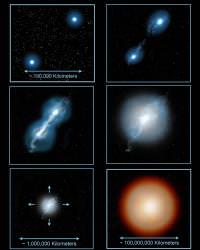 Of all the stars in our galaxy, two classes, known as hydrogen-deficient and R Coronae Borealis are extremely rare. Only a few dozen have been discovered in our entire galaxy. And unlike most of the stars out there, they have almost no hydrogen. Instead, they have abnormally high quantities of a rare isotope of oxygen.
Of all the stars in our galaxy, two classes, known as hydrogen-deficient and R Coronae Borealis are extremely rare. Only a few dozen have been discovered in our entire galaxy. And unlike most of the stars out there, they have almost no hydrogen. Instead, they have abnormally high quantities of a rare isotope of oxygen.
Where could be the origin for these bizarre objects? An international team of astronomers think that colliding white dwarf stars are to blame.
A white dwarf is the fate that awaits our Sun. After it uses up its hydrogen fuel, the star moves onto helium, ballooning up to become a red giant. But once it runs out of helium fuel, it doesn’t have the mass to move up the chain to carbon. Instead it collapses back down to a small dim object, called a white dwarf. Over the course of the next 25 billion years or so, it slowly cools down to the ambient temperature of the Universe.
But if two white dwarfs collide, they could create a new cloud of gas hot enough to start up nuclear reactions again. Two dead stars get another shot at nuclear fusion, briefly becoming a supergiant star again.
Original Source: Gemini News Release
